During the morning oce peak hour of 29th September 2017, around 24 people died and several others were injured in a stampede at Elphinstone Road Suburban Railway Station in Mumbai in what was probably the cruellest stampede in the history of urban India. The stampede happened along the staircase to the only bridge connecting Elphinstone Road Station on the Western Line and Parel Station on the Central Line. The reasons for the stampede were overcrowding on the pedestrian foot overbridge due to rain as well as the sudden swelling of the crowd due to the simultaneous arrival of four trains.
As a reaction to the accident, the Indian Railways identified new foot overbridges across the railway lines and some of them have already been built. However, the proposed bridges would solve only a small part of the problem as they only create more connections to the railway platforms. Accessibility to the mass transit stations from their immediate surroundings of about half a kilometre walking radius has yet to be improved. A similar accident could happen along any of the access ways to the station as there are very few options and the existing ones are narrow, cramped and often in terrible condition. There has been no concerted effort for improvement of station areas in the city.
The structural problem of poor accessibility to mass transit stations is yet to be recognised as the actual cause of the accident.
The geography of the city is a linear urban form suitable for mass transit. Greater Mumbai is a narrow peninsula landform where the southernmost part – Mumbai Island City – continues to be the central business district; it’s about a 4- to 5-kilometre-wide land mass in the sea. The peninsula area is connected to the rest of the metropolitan region through three north-south Suburban Railway lines. The city is structured along the railway lines with high gross density of about 272 persons per hectare housing, a total of around 12.4 million people. Residential, commercial and other mixed-use developments along the suburban station areas are conducive hubs of pedestrian-oriented activities.
Walking is the primary mode of travel in Greater Mumbai. As per the Comprehensive Mobility Plan for Greater Mumbai, 51% of the total trips made in the city are by walking. In Mumbai Island City, 82% of the people access Suburban Rail stations on foot, 13% of them take buses and only 2% hire taxis. This shows that the average commuter performs most everyday activities by walking and using the Suburban Railways.
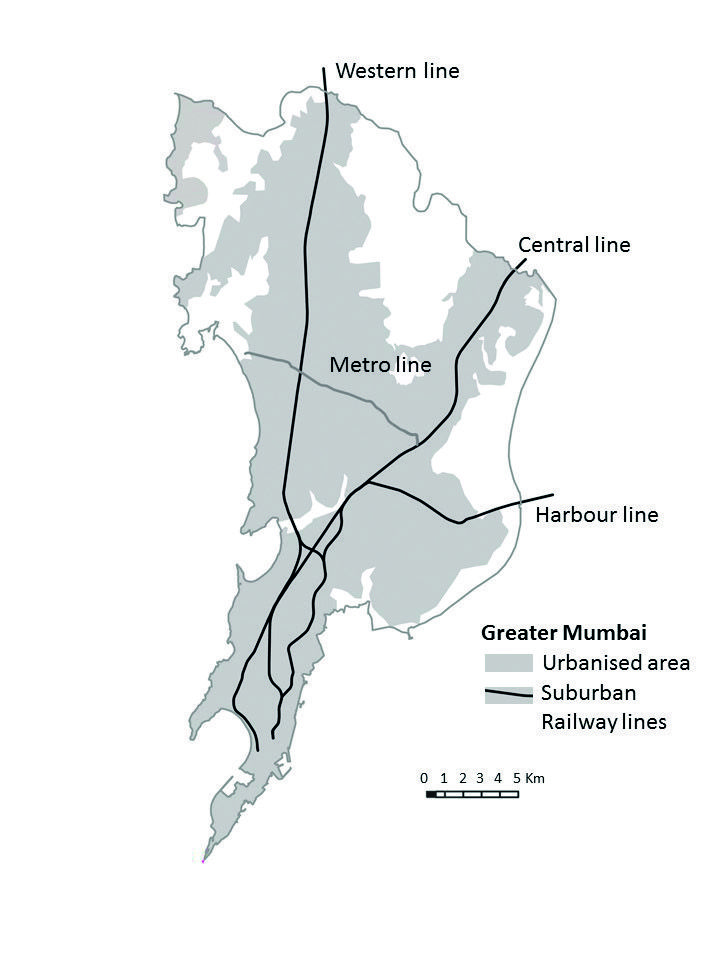
In the Central areas of the Island City, along Elphinstone Road and Parel Railway Stations, the east-west stretch of 3.3 kms is connected by five mass transit lines, namely, Mumbai Metro line-3 (under construction), Western Suburban line, Central Suburban line, Monorail (under construction) and the Harbour Suburban line. This means that along the east-west direction at every 10 to 15 minutes walking distance a mass transit station is available. However, despite such a high density of mass transit connectivity, the opportunities for interconnections between the lines are very weak. Due to the lack of east-west connectivity, people tend to take circuitous north-south routes to interchange between the lines leading to longer trip lengths and congestion along the north-south rail and road corridors. Such inconveniences to commuters also contribute towards reducing modal share of mass transit coupled with rapid increase of personal vehicle ownership.
Challenge of east-west connectivity in Mumbai
The east-west connection continues to be the biggest weakness of the street network in Greater Mumbai. The main constraint is the at-grade railway corridors with very few crossover infrastructures.
In its current condition, east-west overbridges across railway lines are available only at intervals of about 1 to 2 kms or more apart from one another. The interval of connectivity is highly insufficient especially along the Central Mumbai area, which houses high levels of jobs and residents.
Development plans for the city have tried to address this by proposing new roads connecting missing links, but they mostly remain unrealized in the area. While such conditions contribute to perennial traffic jams along the overbridges, they have a severe impact on pedestrian movement. Long circuitous routes to cross the railway lines, unfriendly design of the existing bridges, which provide only marginal space for pedestrians and railway ticketed foot overbridges all discourage pedestrian movement. The city is highly space constrained so adding new transport networks isn’t easy. However, efficiency of the network can be enhanced by planning to complete the road network structure. Pedestrian networks could penetrate urban blocks more easily than vehicular roads to complete the structure. This could be achieved by strategic connections through public land, open spaces, pedestrian priority streets and internal roads of large redevelopments to form a network along the east-west directions.
Lost opportunity of redevelopment in the emerging business district
Redevelopment of redundant mill lands in the Central Mumbai area have led to large scale real estate activity in the last two decades. Today, the areas along Elphinstone Road, Parel and adjoining stations have emerged as alternate locations for large scale offices. However, the redevelopment process has been fragmented and has not helped the substantial enhancement of connectivity or creation of public spaces in the area. The mill lands are large parcels of land with only few roads connecting them with the larger network. The huge plots are redeveloped without sufficient integration with its neighbourhood such that internal road networks of the plots are often disconnected from the adjoining roads.
Architect Charles Correa’s plan for integrated local area development bringing together all the mill lands into a consolidated development to achieve provision of road networks, open spaces, amenities and utilities services remains unrealised.
While such large-scale increase in floor space is attracting exponential growth in the number of commuters, there has been no substantial improvement in accessibility infrastructure in the area.
Need for local area transport plans as urban design proposals
Transport solutions such as enhancing east-west pedestrian corridors needs planning and public participation at the local level. Currently, there is no mandated framework for local area plans under the development planning system for the city. Therefore, local specific solutions through planning and incorporation of the interests of local citizens are often overlooked. A framework of urban design approach integrating mobility solutions and pedestrian infrastructure along with other objectives for the area are urgently required. Funds to implement the solutions could also be generated by linking them with local businesses and other mechanisms dedicated to local improvement.
Pedestrian-oriented east-west corridors for Central Mumbai
The World Resources Institute (WRI), India, is working with the Municipal Corporation of Greater Mumbai (MCGM) to develop a mobility-oriented urban design framework to enhance east-west connectivity in Central Mumbai. Various surveys were conducted across Central Mumbai to identify potential pedestrian corridors connecting major functions with mass transit nodes in the area. The potential corridors consist of a system of new key connections and strengthening of pedestrian infrastructure along existing street networks. The corridors would help nearly double the pedestrian penetration by creating at least one connection in between the existing east-west connecting roads across the railway lines. The proposals take advantage of mill lands to be redeveloped and government or municipal properties to form a dedicated pedestrian network connecting major transport generators with mass transit nodes. Activities long the existing streets such as on-street parking, street vending and other activities need to be reorganised to develop a dedicated pedestrian infrastructure.
The approach is to reduce the current domination of vehicles and humanise the streets by creating a system of complete streets that accommodate everyone.
Need to humanise the streets
Cities often prioritises investments in infrastructure for car-based travel without realizing that this not only invites more traffic congestion but also leads to a more unequal city. Data from surveys conducted along the proposed pedestrian priority corridor defies popular perceptions of traffic congestion. Along all the stretches of the corridor, the number of people travelling in various types of vehicles is found to be far less than the number of pedestrians walking along the corridor during peak hours. This means, the carriageway for the vehicles occupies a disproportionately higher width of street space to support a lower number of actual people travelling in vehicles. On the other hand, a very high number of pedestrians walk in a disproportionately lower width of street space in unsafe and over-crowded conditions. The existing system reflects clear inequality, as pedestrians are marginalised. Such marginalisation of humans and domination of vehicles on the streets does not result in reduced traffic congestion. Dedicating a wider street space for pedestrians could influence more vehicle users to shift to walking and therefore would contribute towards reducing traffic congestion. Such an approach of humanising the streets is essential to develop infrastructure to enable dignity in walking.
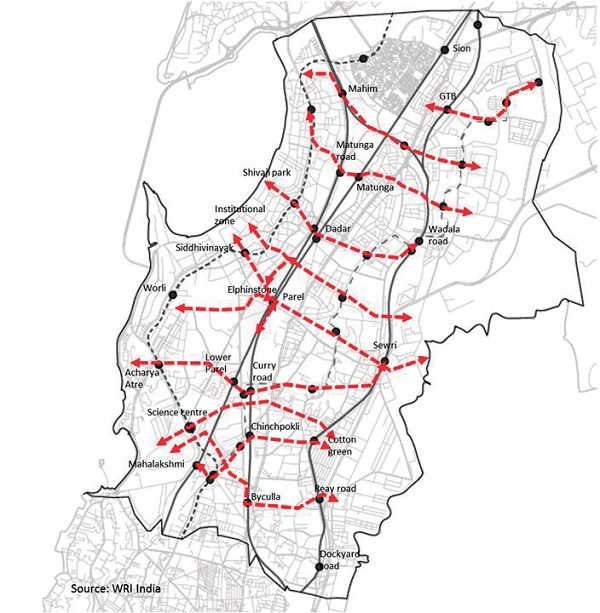
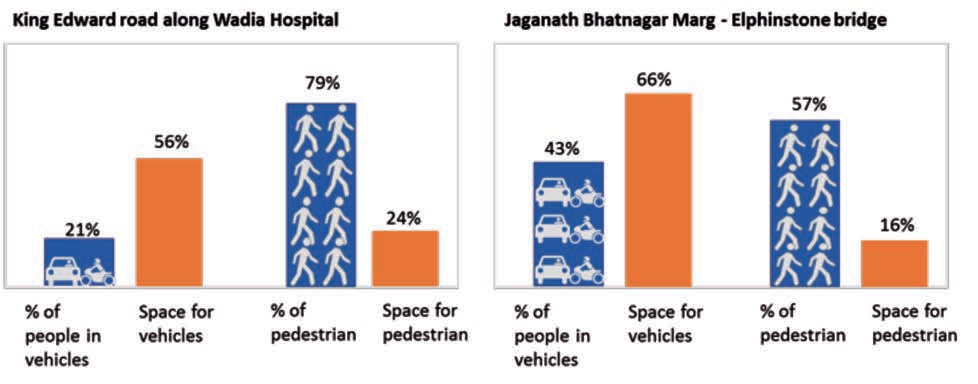
Dignity of walking
The state of feeling worthy of honour and respect while walking in a public space is a vital contribution a city can offer for the psychological health of its citizens. Today, according to popular perception, people walking on the street are considered poor and unable to afford a car.
Pedestrian infrastructure could be a great flattening agent that welcomes the rich, the poor and the vulnerable, all being treated with an equal sense of worthiness. This aspect of pedestrian dignity is often undermined by decision makers. Obstructions on walkways, lack of space and clear definition of walkways, conflicts with vehicles, quality of infrastructure and lack of cleanliness all constantly push the pedestrian into uncomfortable and unpleasant conditions.
Physical obstructions on walkways are everyday struggles for everyone walking through the area, especially the vulnerable and the physically challenged. Physical obstructions on the footpath are of various types such as constant ups and downs on the pavement, extended platforms of shops/ buildings, ramps to enter buildings or properties, unorganised structures like planter boxes, platforms around trees, spill over of shop display/other activities, temporary structures of street vendors/housing, street vendors without any structure, utility boxes, bus stop structures, parked vehicles, garbage dumping or collection activities and storage on footpaths. Each of the obstructions is related to one or more stakeholders; the obstructions exist because of the stakeholder’s action or inaction. They not only create undignified conditions for pedestrians but also deter them from walking. Most of the walkways along the identified east-west corridors are highly insufficient, often interrupted with a number of obstructions. These are also the corridors that have the highest intensity of pedestrian users, suggesting the need for a rethink of our priorities of investment on development.
Getting priorities right
Cars do not play a major role in transporting large sections of the population in Greater Mumbai. Mass transit and footpaths to the mass transit stations play a major role in helping people to undertake their daily activities with ease. But the city is still planning large investments to develop large scale, car-oriented road projects. The number of people expected to be served by such a project is a very small number of car users, compared to the number of people who walk and use mass transit. Therefore, there is an urgent need to shift priorities, which would serve larger sections of the population and invest in pedestrian infrastructure connecting mass transit. The project for enhancing pedestrian east-west connectivity would be a vital investment to enhance pedestrian infrastructure in the Central Mumbai area. To bring a transformative change, initial pilot projects help to test the solutions and to adapt and accommodate local dynamics before scaling-up across the city.
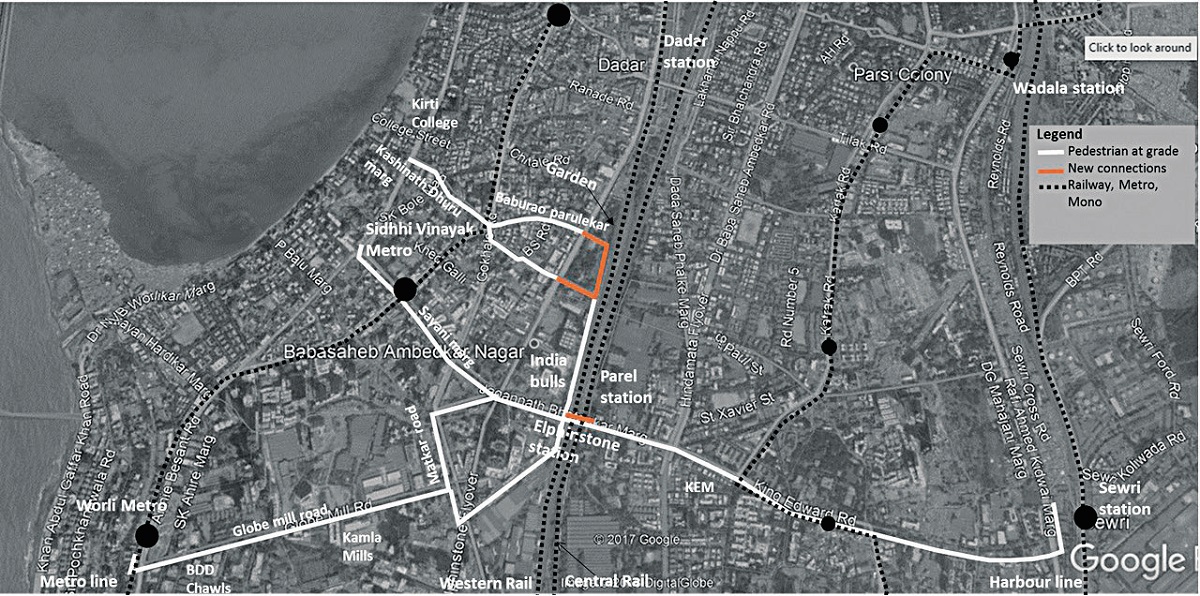
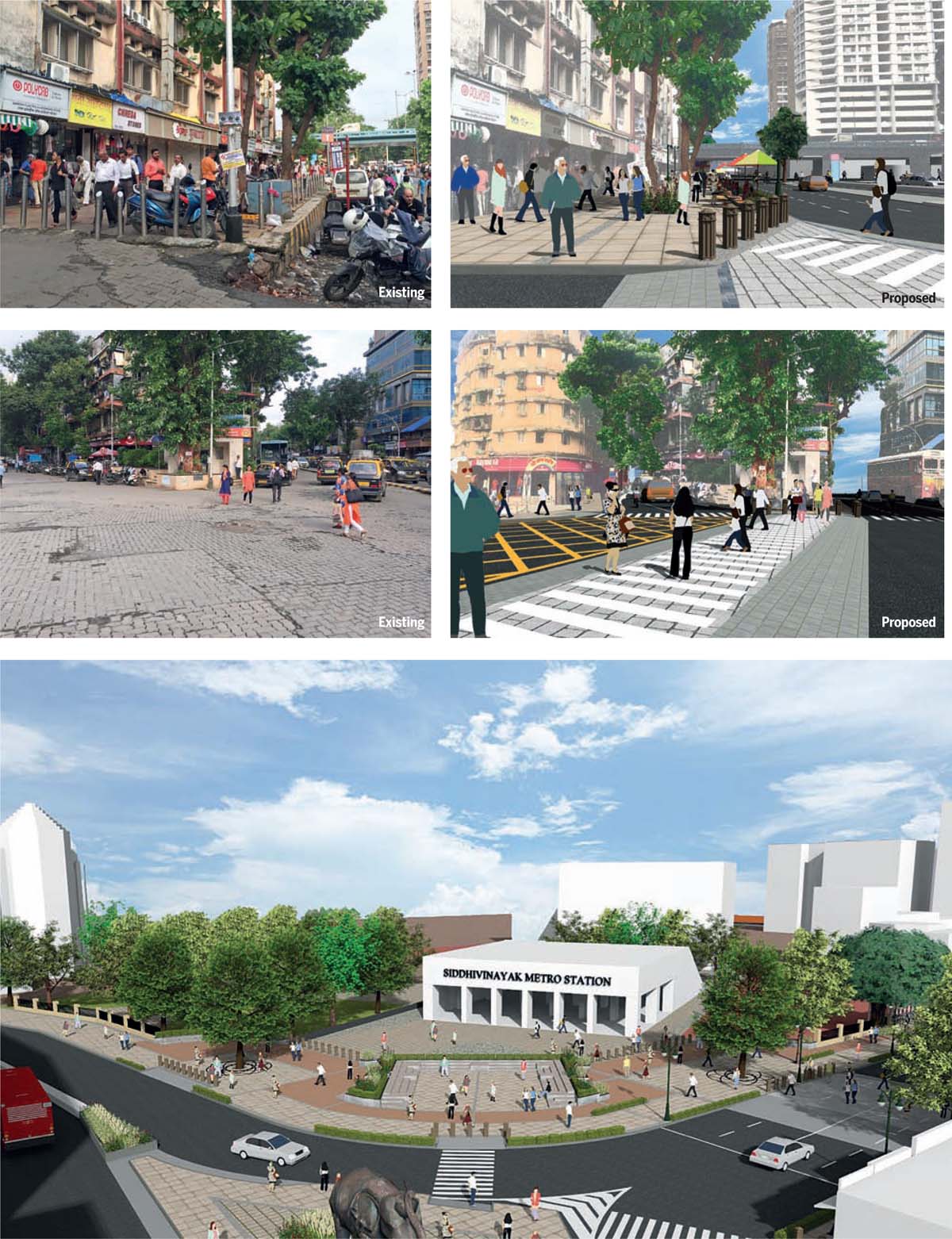
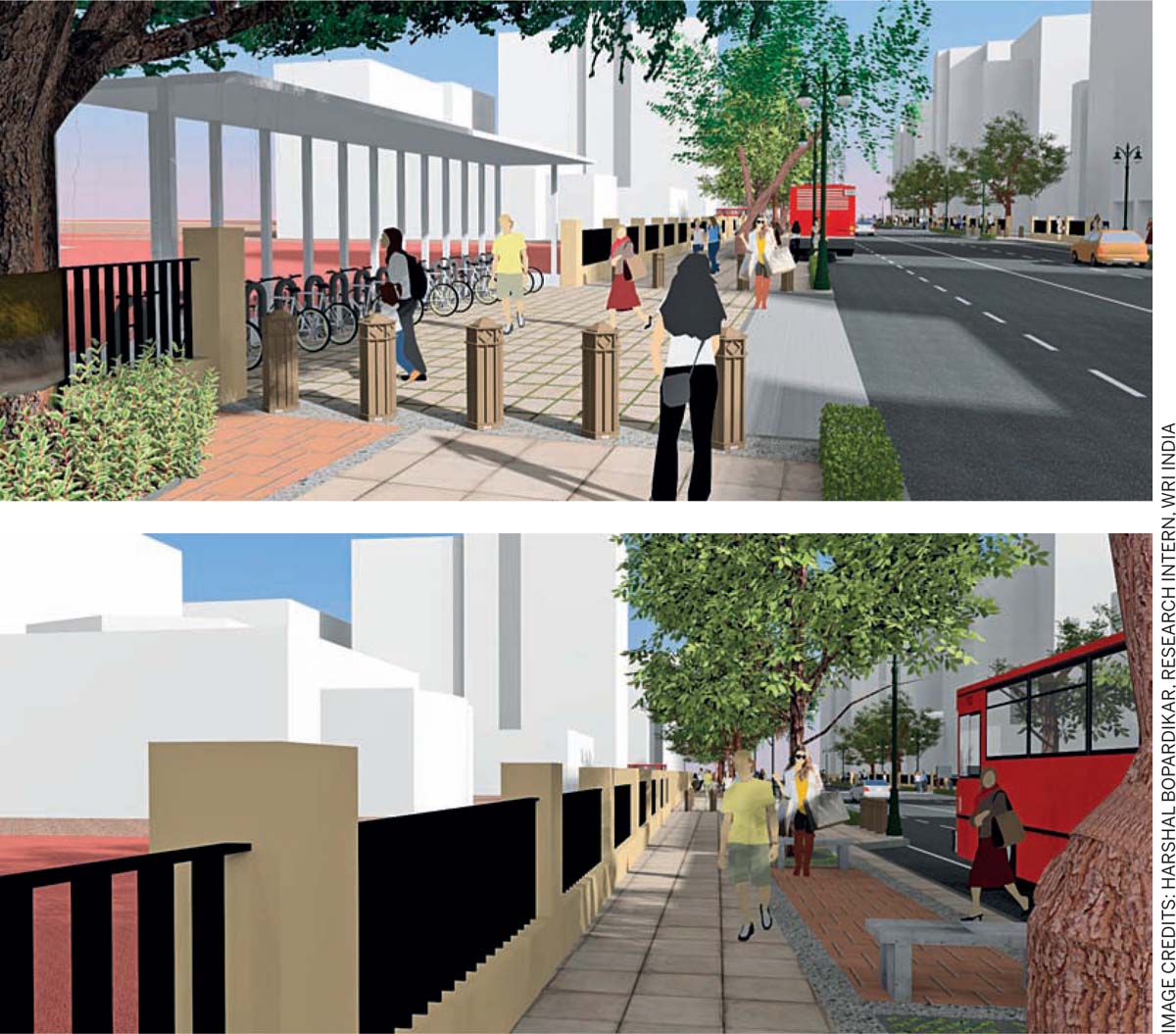
Bottom: Places to walk, wait and relax
Pilot project
The approach for enhancing east-west connectivity is to ensure conducive conditions to walk from various functions in the area to mass transit stations, thereby reducing the need to travel by vehicles. While developing the basic infrastructure for walking, the project also intends to develop a clear image for the corridor as an effective system to support pedestrian movement. Hence the functional configuration as a public space, streetscape elements and furniture, construction material and management of underground and over-ground utilities such that the corridors not only demonstrate progressive solutions towards equitable streets but also render a characteristic image to the place.
Through discussions with MCGM, a pilot project to demonstrate enhancement of pedestrian connectivity along the east-west corridors of Central Mumbai was identified. This project intends to develop pedestrian priority corridors connecting the heritage node of a famous religious place, institutional node and employment node with a residential catchment.
Iconic and negotiated strategy
The pilot corridor intends to connect areas of intense functions with key transport nodes in the area. These areas often face traffic congestion, with multiple-use street space. However, there are also considerable variations in availability of street space as opportunities to enhance the pedestrian infrastructure along the corridor. Stretches along important landmarks where sufficient street space is available to expand pedestrian infrastructure are to be developed as iconic stretches helping to build a clear public image for the corridor; in stretches that pass through narrower roads in residential areas, the width of the pedestrian corridor would be optimised negotiating the local conditions. Therefore, the proposals respond to the reality and address varied constraints.
The pedestrian corridors will have continuous footpaths, free of any obstruction and walkways at the same level without ups and downs. This is to be achieved by removing parking on one side of the street and optimising it on the opposite side. Also, plans are on to organise street vending, bus stops, taxi stands and other transport-related infrastructure to ensure space for various types of pedestrian-oriented functions such as undisturbed walking space, spaces to wait and to relax.
IMAGE CREDITS: HARSHAL BOPARDIKAR, RESEARCH INTERN, WRI INDIA


Comments (0)